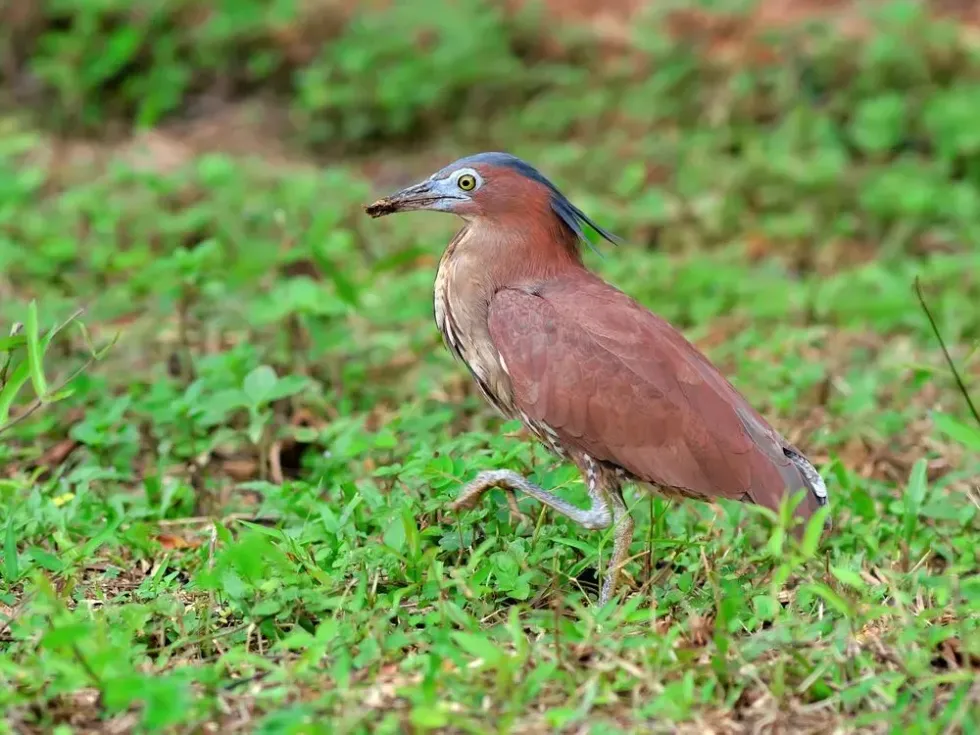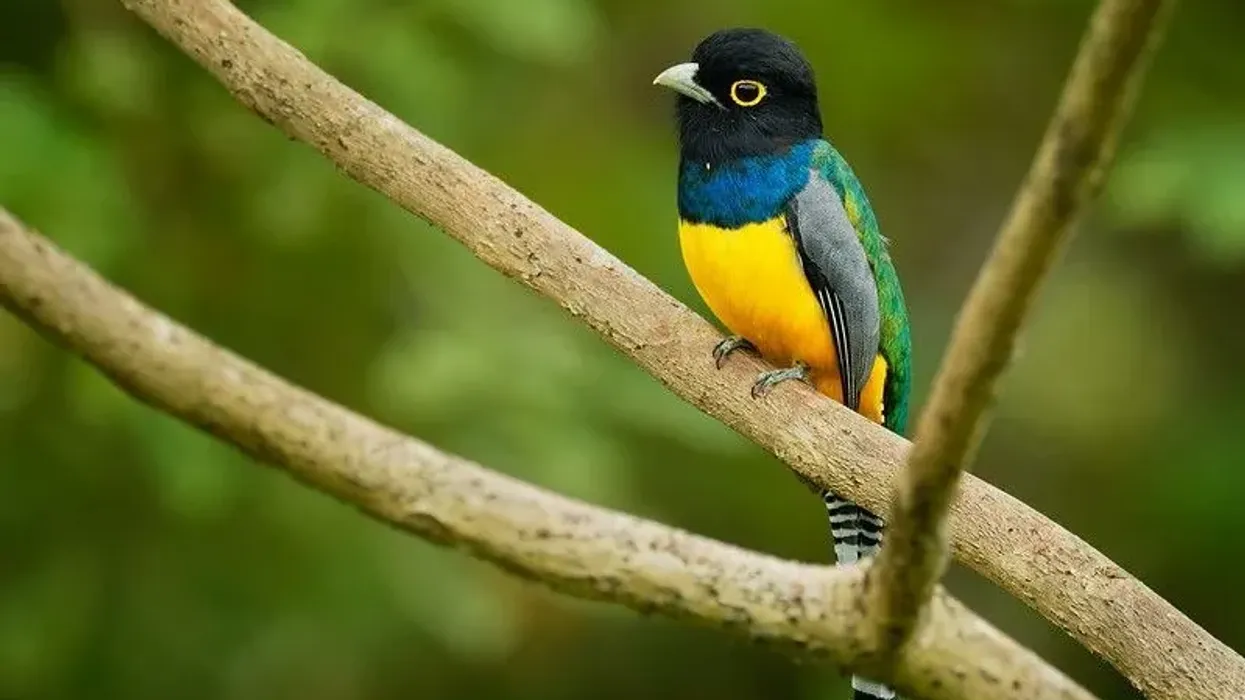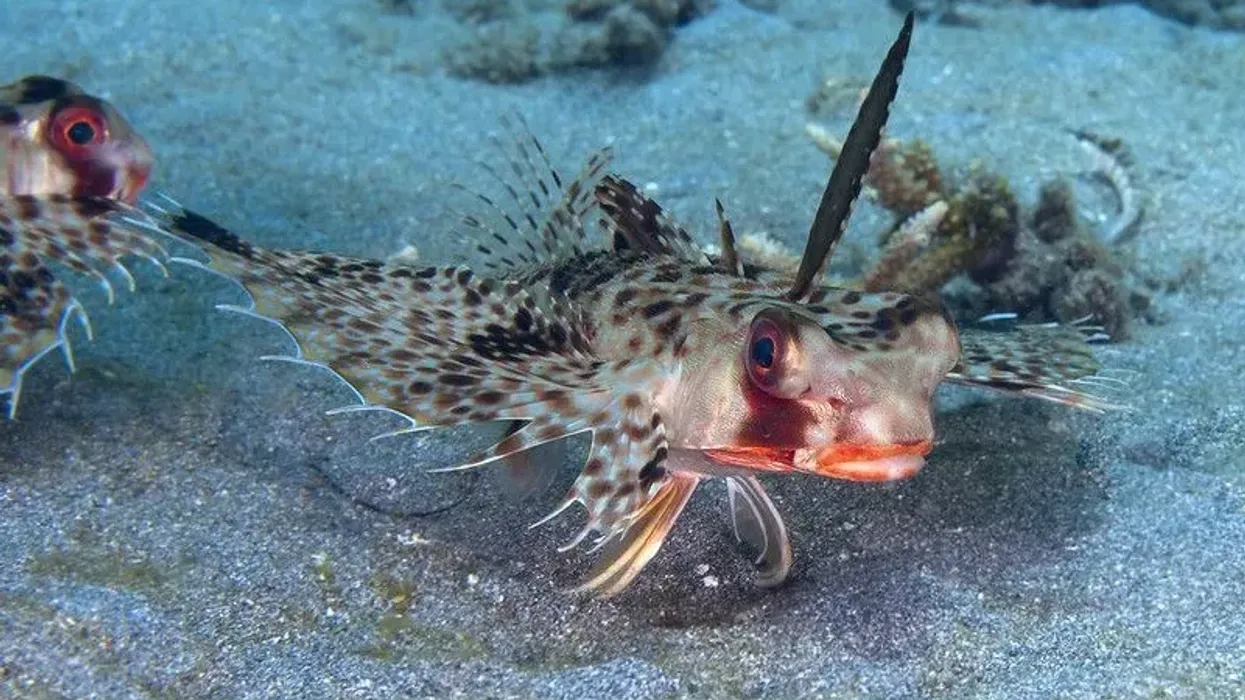The Malayan night heron, Gorsachius melanolophus (Raffles, 1822), is an odd-looking night heron species of the family Ardeidae and order Pelecaniformes. It is a reddish-brown, medium-sized bird with a black crown and underparts with streaks.
This heron is also known by other names, such as the tiger bittern and the Malaysian night heron. It has two recognized subspecies: G. m. melanolophus (Raffles, 1822) and G. m. minor(Hachisuka, 1926).
The Malaysian night heron has extensive breeding and resident range that includes India, China, Bangladesh, Nepal, the Philippines, and Southeast Asia. Plus, wintering populations of the species are found in Sri Lanka, Japan, Indonesia, and the Thai-Malay Peninsula.
The natural habitat of the birds includes dense and moist tropical and subtropical forests, marshes, swamps, and streams of the low wetlands to secondary scrubs, reservoirs, and evergreen forests of moderate elevations. Members of the species are solitary nocturnal foragers preying on insects, earthworms, mollusks, frogs, lizards, and occasionally small fish.
Do you find these herons interesting? Then read on to know more about this amazing heron species!
If you like what you read, do check out interesting facts about other bird species, such as the Australian pelican and Sarus crane.
Malayan Night Heron Interesting Facts
What type of animal is a Malayan night heron?
The Malayan night heron (Gorsachius melanolophus) is a medium-sized species of heron found in eastern and southern Asia. It belongs to the family Ardeidae and the order Pelecaniformes.
What class of animal does a Malayan night heron belong to?
The Malayan night heron (Gorsachius melanolophus) belongs to the class of birds.
How many Malayan night herons are there in the world?
According to assessments by the International Union for Conservation of Nature (IUCN) Red List, the total population size of the Malayan night heron is about 1,300-13,000 individuals.
Where does a Malayan night heron live?
From the Malayan night heron range map, it is evident that the species has a large range in southern and eastern Asian regions. The breeding range of the species includes India, the Nicobar Islands, Thailand, Nepal, Bangladesh, Vietnam, Cambodia, Laos, the Philippines, South China, and Japan.
The non-breeding range of the species spreads across west India, Thailand, Sri Lanka, Cambodia, Laos, Vietnam, Malaysia, South China, Indonesia, Japan, and the Philippines. Wintering populations of the species are common in Japan, the Thai-Malay Peninsula, Sri Lanka, and Indonesia.
What is a Malayan night heron's habitat?
The Malayan night heron (Gorsachius melanolophus) is found in areas of high rainfall. Its habitat includes moist tropical and subtropical forests, marshes, streams, and swamps of the low wetlands to secondary scrubs, reservoirs, and evergreen forests of moderate altitudes.
The birds are common in reed beds during migration and are often found in human environments such as vegetable gardens, pastures, and flooded rice fields.
Who do Malayan night herons live with?
The Malayan night heron (Gorsachius melanolophus) is a solitary and territorial heron species.
How long does a Malayan night heron live?
The lifespan estimate of the Malayan night heron is not available. Another night heron species, the black-crowned night heron of the genus Nycticorax, lives for about 20 years.
How do they reproduce?
The breeding season of the Malayan night heron differs with the geographical region where a population resides. For example, birds resident in southwest India breed during May-August, whereas the resident birds of Taiwan breed during April-September.
The species nests in tall trees and bamboo of lowland forests and also in reed beds. The breeding nest is usually near water. Although the birds are solitary in nature, the adult birds often nest close together in colonies, with numbers reaching up to 20 nests.
Solitary nesting is also observed. Both members of a breeding pair participate in nest-building, which is usually a small and delicate platform of sticks lined with grass and leaves and hidden away amidst tree branches.
The female bird usually lays a clutch comprising three to five eggs, chalky white in color with a tinge of green or blue. Both parents incubate the eggs for about 32-34 days.
After the eggs hatch, the juvenile birds take about 43 days to fledge. Along with the parents, the juvenile birds also participate in feeding the newborns. A description of this heron's courtship behavior and nesting biology is not available.
What is their conservation status?
As per the IUCN Red List, the conservation status of the Malayan night heron (Gorsachius melanolophus) is a species of Least Concern. Even though their global population trend is unknown, the birds do not fulfill the criteria for a Vulnerable species status.
Malayan Night Heron Fun Facts
What do Malayan night herons look like?
As per the field description of the Malayan night heron, the adult bird has a reddish-brown or chestnut brown plumage and a black crown. The adult birds also have black underwings, a black stripe running between the throat and the breast, and underparts with streaks.
Breeding members of the species have a bright blue patch of skin present between the eyes and the bill; this bright blue facial patch is dull in non-breeding individuals and yellowish in juvenile birds.
The Malayan night heron may look similar to the Japanese night heron, but the two heron species differ in several aspects. For example, the Malayan night heron is reddish-brown with a black crown and white-tipped outer wings, whereas the Japanese night heron has a dark plumage with tawny-tipped wings.
Also, the bill of the Malayan species is longer and thinner. The underparts of both species have streaks.
The juvenile Malayan night herons have a dark brown and white, prominently barred and spotted plumage. The crown is blackish, barred, and spotted white, and the bill is short and downward arching. The back and wings have fine black and white spots, and the underparts are mottled.

How cute are they?
The Malayan night heron is not conventionally cute. It is rather odd-looking with squat and thick proportions and is quite easy to spot in the field.
How do they communicate?
When in flight, the typical Malayan night heron call sounds like arh-arh-arh and a low-pitched kwok. The song of the bird is a deep, repetitive, and mournful series of thuk-thuk-thuk-thuk or wu-wu-wu notes.
How big is a Malayan night heron?
An adult Malayan night heron may range in length between 17.7-19.3 in (45-49 cm). Plus, the Malayan night heron wingspan is between 34-34.2 in (86-87 cm). The species is larger than the yellow-crowned night heron of the genus Nyctanassa and the family Ardeidae. Green herons are of a size similar to that of the Malayan night heron.
How fast can a Malayan night heron fly?
The flight speed of the Malayan night heron is not available. However, the black-crowned night heron is reported to attain flight speeds of around 34 mph (55 kph).
How much does a Malayan night heron weigh?
An adult Malayan night heron weighs between 0.83-0.99 lb (377-450 g).
What are the male and female names of the species?
In general, male and female night herons do not have distinct names. Hence, the terms Malayan night heron male and Malayan night heron female are used.
What would you call a baby Malayan night heron?
A baby Malayan night heron would be called a chick, nestling, fledgling, or simply a juvenile.
What do they eat?
The food of Malayan night herons mainly includes insects such as beetles. Besides, the birds also feed on large earthworms, mollusks, lizards, frogs, and sometimes small fish.
Are they dangerous?
Being a territorial species, night herons may get aggressive when defending their nests.
Would they make a good pet?
Since the Malayan night heron is a wild and territorial bird, it is not wise to make pets out of them. Besides, these are forest-dwelling birds with specific habitat requirements and are not at all suitable for a domestic environment.
Did you know...
A group of herons has many collective names, such as siege, scattering, sedge, and hedge.
Are Malayan night herons endangered?
The Malayan night herons are not endangered. They are a species of Least Concern in the IUCN Red List.
Are night herons nocturnal?
Yes, the night herons are nocturnal, and they are named so because of their night-time feeding habits.
Here at Kidadl, we have carefully created lots of interesting family-friendly animal facts for everyone to discover! For more relatable content, check out these green heron facts and northern gannet facts for kids.
You can even occupy yourself at home by coloring in one of our free printable bird coloring pages.









